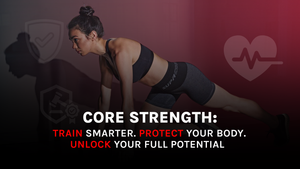Why Core Strength Is the Hidden Key to Performance and Injury Prevention
When you think about athletic performance, what comes to mind first? Speed, endurance, power, agility — these are the obvious markers of success in sport and fitness. But there’s one factor that underpins them all, often overlooked until something goes wrong: core strength.
The “core” is more than just abs. It’s a complex network of muscles that stabilise, balance, and transfer power through the entire body. Whether you’re sprinting down the field, lifting in the gym, or simply bending to pick something up, your core is at work. And when it’s weak or unstable, performance suffers and injury risk skyrockets.
At Supacore, we’ve seen firsthand how building and supporting core strength can make the difference between thriving on the field and sitting on the sidelines. Let’s explore why your core is the hidden key to performance and injury prevention — and how you can train and support it for long-term success.
What Is the Core, Really?
Many people equate the core with the six-pack muscles (rectus abdominis). But true core strength goes much deeper. The core includes:
-
Rectus abdominis (front abdominal muscles)
-
Transverse abdominis (deep “corset” muscle that stabilises the spine)
-
Obliques (side muscles, essential for rotation and stability)
-
Pelvic floor muscles
-
Diaphragm
-
Multifidus and spinal stabilisers
-
Glutes and hip muscles
Together, these muscles form a powerhouse that stabilises your spine and pelvis, allowing your limbs to generate and transfer force efficiently.
Why Core Strength Matters for Performance
1. Power Transfer
Every athletic movement — running, jumping, throwing, kicking — relies on force transfer between the upper and lower body. A strong, stable core ensures that energy isn’t “leaked” along the way, making movements more efficient and powerful.
2. Balance and Stability
From quick changes of direction on the court to maintaining form during a heavy squat, your core is the anchor that keeps your body stable. Athletes with stronger cores can maintain balance under pressure, giving them an edge in performance.
3. Endurance and Efficiency
A weak core forces other muscles (like the lower back or hips) to compensate, leading to faster fatigue. Strong core muscles improve posture and biomechanics, helping athletes move more efficiently and sustain performance for longer.
Core Strength and Injury Prevention
When the core is unstable, the risk of injury increases dramatically. Here’s why:
1. Reduced Spinal Protection
A weak core means the spine lacks stability, increasing the risk of lower back pain, disc issues, and overuse injuries.
2. Pelvic Instability
The pelvis is the foundation for movement. Without core stability, athletes are more prone to groin strains, hamstring injuries, and hip problems.
3. Poor Movement Mechanics
Without core support, movements like landing from a jump or pivoting during sport put excessive stress on the knees and ankles, contributing to injuries like ACL tears and sprains.
4. Postural Issues
Poor posture from weak core muscles places strain on the neck, shoulders, and back, increasing the likelihood of chronic pain and overuse injuries.
Training the Core: More Than Sit-Ups
Improving core strength requires more than endless crunches. In fact, sit-ups alone often do little to improve functional stability. Instead, focus on exercises that challenge the core in multiple planes of motion and mimic athletic movements.
Functional Core Exercises:
-
Planks and side planks (isometric stability)
-
Dead bugs and bird-dogs (spinal stability and coordination)
-
Pallof presses (anti-rotation strength)
-
Glute bridges and hip thrusts (core + glute integration)
-
Medicine ball throws and slams (power transfer and rotation)
These exercises target the deep stabilisers of the core, building strength that translates directly to sport and daily life.
The Role of Compression Wear in Core Stability
While training builds core strength, external support can also make a big difference in both performance and injury prevention.
Supacore’s CORETECH® compression technology is designed to provide targeted support to the pelvis, hips, and lower back — the foundation of the core. Unlike standard compression wear, CORETECH® has a patented waistband and body-mapped panels that act like a second layer of stability.
Benefits for athletes include:
-
Reduced risk of hamstring, groin, and lower back injuries.
-
Improved posture and alignment during high-intensity movement.
-
Reduced muscle vibration and fatigue, enhancing endurance.
-
Faster recovery by improving circulation and reducing soreness.
In short: compression wear doesn’t replace core training, but it reinforces it — giving athletes the edge in both performance and protection.
Everyday Applications Beyond Sport
Core strength isn’t just for elite athletes. It’s essential for everyday movement:
-
Parents lifting their kids or prams.
-
Workers on their feet all day.
-
Gym-goers wanting to train safely and effectively.
Supporting core stability through training — and tools like CORETECH® compression wear — helps everyone move with more confidence and less risk of injury.
Building a Core-First Mindset
For too long, core training has been treated as an afterthought — a few crunches at the end of a workout. But when you shift your mindset to core-first training, the results are undeniable.
Stronger core = better performance, faster recovery, fewer injuries.
And with the right support systems in place — from functional exercise routines to medical-grade compression wear — athletes and everyday movers alike can build resilience that lasts.
Final Thoughts
Core strength is the hidden key that unlocks athletic potential and protects against injury. It’s not about aesthetics or chasing a six-pack — it’s about stability, power, and longevity in sport and life.
By prioritising functional core training and supporting your body with tools like Supacore CORETECH® compression wear, you can move stronger, recover faster, and perform at your best — no matter your game.
Because when your core is strong and supported, everything else falls into place.
Stay strong. Stay supported. Stay supa.

